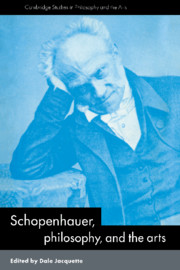Book contents
- Frontmatter
- Contents
- List of contributors
- Editor's acknowledgments
- List of abbreviations
- 1 Schopenhauer's metaphysics of appearance and Will in the philosophy of art
- PART I The work of art: Schopenhauer on the nature of artistic creation
- PART II The experience of beauty: Schopenhauer's theory of aesthetic encounter
- 5 Pleasure and knowledge in Schopenhauer's aesthetics
- 6 Schopenhauer and aesthetic recognition
- 7 Schopenhauer on beauty and ontology
- 8 Schopenhauer, Heidegger, art, and the will
- PART III Schopenhauer's enduring influence on the arts: idealism and romanticism
- Bibliography of selected sources on Schopenhauer's aesthetics
- Index
7 - Schopenhauer on beauty and ontology
Published online by Cambridge University Press: 05 May 2010
- Frontmatter
- Contents
- List of contributors
- Editor's acknowledgments
- List of abbreviations
- 1 Schopenhauer's metaphysics of appearance and Will in the philosophy of art
- PART I The work of art: Schopenhauer on the nature of artistic creation
- PART II The experience of beauty: Schopenhauer's theory of aesthetic encounter
- 5 Pleasure and knowledge in Schopenhauer's aesthetics
- 6 Schopenhauer and aesthetic recognition
- 7 Schopenhauer on beauty and ontology
- 8 Schopenhauer, Heidegger, art, and the will
- PART III Schopenhauer's enduring influence on the arts: idealism and romanticism
- Bibliography of selected sources on Schopenhauer's aesthetics
- Index
Summary
THE JUDGMENT OF TASTE
We begin our exploration of Schopenhauer's conception of beauty by summing up some components of Kant's system related to that subject. This is done, not because of the chronological or historical sequence but because of the built-in relation of Schopenhauer to Kant on that issue. We may say already here that Schopenhauer integrated several of Kant's components of the exploration and gave them a new dimension and status.
Kant says that the beautiful is that which pleases in the mere estimate of it; it is not in sensation or by means of a concept. From the position of judgment related to the beautiful, it is said that the judgment of taste determines its objects in terms of delight – as a thing of beauty. Though these components, both of taste and delight, are prominent, there is a claim to the agreement of everyone just as if it were objective. An example is that to say that this flower is beautiful is tantamount to repeating its own proper claim to the delight of everyone. An additional characteristic of art is that the work of art is organized or a self-organized being. An organized being possesses inherent formative power. It is a self-propagating formative power, which cannot be explained by any mechanism.
The conjunction of delight on the one hand and the inner structure of the work of art on the other becomes manifest in the absense of interest, that is to say of taking advantage of the work of art. Every interest vitiates the judgment of taste and robs it of its impartiality. It is a pure judgment of taste, uninfluenced by charm or emotion.
- Type
- Chapter
- Information
- Schopenhauer, Philosophy and the Arts , pp. 150 - 161Publisher: Cambridge University PressPrint publication year: 1996

